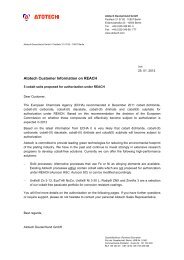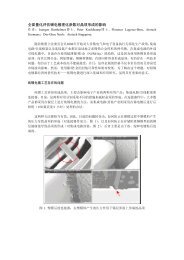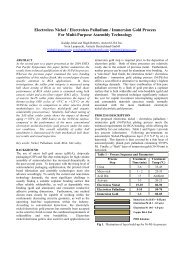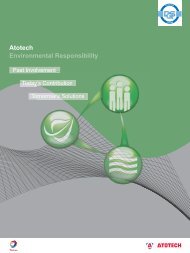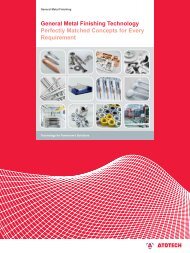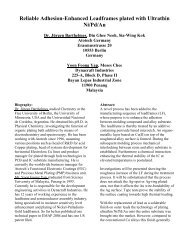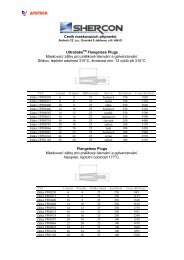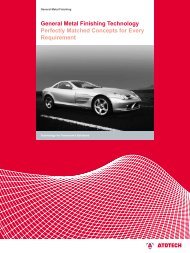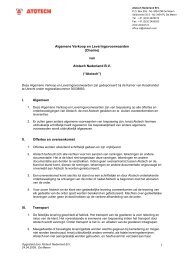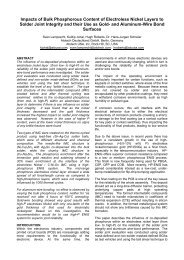Quartz Crystal Microbalance used to Characterize ... - Atotech Inc.
Quartz Crystal Microbalance used to Characterize ... - Atotech Inc.
Quartz Crystal Microbalance used to Characterize ... - Atotech Inc.
Sie wollen auch ein ePaper? Erhöhen Sie die Reichweite Ihrer Titel.
YUMPU macht aus Druck-PDFs automatisch weboptimierte ePaper, die Google liebt.
1 Introduction<br />
Eugen G. Leuze Verlag<br />
Journ. f. Electrochemistry a. Plating Technology<br />
<strong>Quartz</strong> <strong>Crystal</strong> <strong>Microbalance</strong> <strong>used</strong><br />
<strong>to</strong> <strong>Characterize</strong> Electrochemical Metal Deposition<br />
Untersuchungen des elektrochemischen Abscheideverhaltens<br />
mit Hilfe der Quarzmikrowaage<br />
By Olaf Kurtz, Jürgen Barthelmes, Robert Rüther, Mathias Wünsche und Constanze Donner, Berlin<br />
Thanks <strong>to</strong> the piezoelectric behaviour of quartz and its adoption in the quartz crystal microbalance (QCM), a<br />
technique is available which allows the minutest changes in mass <strong>to</strong> be followed as a function of time. Frequency<br />
shifts as a function of time provide valuable information, for example on the mass or thickness of an electroplated<br />
or chemically deposited coating. Growth or deposition rates as well as current efficiencies of electrochemical<br />
processes are likewise accessible in this way. Time resolution is of the order of a few milliseconds, mass<br />
resolution of the order of nanograms. Using this technique one can, for example, follow the change in current<br />
efficiency of copper deposition from an acid bath due <strong>to</strong> inhibition resulting from the adsorption of organic<br />
molecules or the formation of an electrochemical double layer. One application of the quartz crystal microbalance<br />
reported here is the study of very thin electroplated films in the range 5 <strong>to</strong> 20 nm.<br />
Aufgrund des piezoelektrischen Effekts an Quarz und dessen Umsetzung in der elektrochemischen Quarzmikrowaage<br />
liegt eine Methode vor, mit der geringste Massenänderungen zeitlich erfasst werden können. Frequenzverschiebungen<br />
als Funktion der Zeit bilden wertvolle Informationen zum Beispiel über die Masse oder<br />
Schichtdicke einer galvanischen oder chemischen Abscheidung, Wachstums- beziehungsweise Abscheideraten<br />
sowie Stromausbeute von elektrochemischen Verfahren. Die zeitliche Auflösung liegt im Bereich von wenigen<br />
Millisekunden und die Massenauflösung im Bereich von Nanogramm. Mit der Methode lässt sich beispielsweise<br />
die Änderung der Stromausbeute im Verlaufe einer galvanischen Abscheidung aufzeigen, wie sie bei der<br />
Abscheidung von Kupfer aus einem sauren Elektrolyten durch eine Inhibierung, aufgrund adsorbierter organischer<br />
Moleküle oder durch die Bildung einer elektrochemischen Doppelschicht, auftritt. Eine Anwendung der<br />
Quarzmikrowaage ist beispielsweise die Untersuchung von sehr dünnen galvanischen Schichten im Bereich von<br />
5 bis 20 nm.<br />
Key Words: <strong>Quartz</strong> crystal micro-balance, electrochemical quartz crystal micro-balance, behaviour of deposition,<br />
microanalysis, electrolyte development, characterisation of electrolyts, time resolution, thin films, QCM<br />
Schlüsselwörter: Quarzmikrowaage, elektrochemische Quarzmikrowaage, Abscheideverhalten, Mikroanalyse,<br />
Elektrolytentwicklung, Elektrolytcharakterisierung, zeitliche Auflösung, dünne Schichten, QMW<br />
Paper: Received: 2009-01-29 / Received in revised form: 2010-04-23 / Accepted: 2010-04-29<br />
The <strong>Quartz</strong> <strong>Crystal</strong> <strong>Microbalance</strong> (QCM) is a very<br />
sensitive analytical method that permits the in-situ<br />
detection of interfacial processes, e.g. weight gain by<br />
surface electrodeposition. The measurement principle<br />
is based on the change in the natural frequency<br />
of a quartz resona<strong>to</strong>r that can be excited <strong>to</strong> a resonant<br />
oscillation by AC voltage (piezoelectricity) [1-5].<br />
The QCM can be <strong>used</strong> under vacuum, in gas phase<br />
and more recently in liquid environments. Under<br />
vacuum it can be <strong>used</strong> for moni<strong>to</strong>ring the rate of thin<br />
1 Einleitung<br />
Die Quarzmikrowaage (QMW) ist eine sehr empfindliche<br />
analytische Methode, die eine in situ-Detektion<br />
von Grenzflächenprozessen, wie zum Beispiel die<br />
galvanische Massenabscheidung auf Oberflächen, ermöglicht.<br />
Das Prinzip basiert auf der Eigenfrequenzänderung<br />
eines Schwingquarzes, der durch Anlegen<br />
einer Wechselspannung zu einer resonanten Schwingung<br />
angeregt werden kann (Piezoelektrizität) [1-5].<br />
Die QMW kann unter Vakuum, in Gasphase und seit<br />
kurzem auch in Flüssigkeiten eingesetzt werden. Untersuchungen<br />
zu Abscheideraten von Dünnfilmen<br />
1<br />
J. E. P. T. 5/2010
2<br />
J. E. P. T. 5/2010<br />
Journ. f. Electrochemistry a. Plating Technology<br />
film deposition. In liquids, for example, it can be effectively<br />
<strong>used</strong> <strong>to</strong> determine the affinity of bio-molecules,<br />
viruses or polymers <strong>to</strong> surfaces or <strong>to</strong> investigate<br />
corrosion phenomena. For its use in liquids the QCM<br />
is completed with an electrochemical set-up. In this<br />
case, the microbalance is called the Electrochemical<br />
<strong>Quartz</strong> <strong>Crystal</strong> <strong>Microbalance</strong> (EQCM) [6-8].<br />
Generally, the EQCM can assist in providing information<br />
about the plating mechanism and methodology,<br />
essential for process and electrolyte development.<br />
The ratio between the mass deposited and the <strong>to</strong>tal<br />
charge measured at the electrode, corresponds <strong>to</strong> the<br />
process current efficiency.<br />
The QCM is very surface sensitive technique and so<br />
the detection limit for mass deposition lies in the order<br />
of a few nanograms. Today it is <strong>used</strong> in Chemistry,<br />
Physics Materials and Surface Science as well as for<br />
maritime and medical research and development.<br />
2 Theoretical Background<br />
of the QCM Technology<br />
In 1880 the Curie brothers, Pierre and Jacques, demonstrated<br />
the first piezoelectric effect as the ability of<br />
some materials (notably crystals and certain ceramics)<br />
<strong>to</strong> generate an electric potential in response <strong>to</strong><br />
applied mechanical stress. Conversely, a mechanical<br />
deformation (ability of a substance <strong>to</strong> shrink or expand)<br />
is produced when an electric field is applied.<br />
This effect is formed in crystals that crystallize in<strong>to</strong><br />
Non-centro-symmetric Space Group, i.e. quartz. Only<br />
20 of the overall 32 crystallographic classes show<br />
this piezoelectric phenomenon and from these, only<br />
a small minority was found suitable for practical applications.<br />
There are two criteria that a suitable piezoelectric<br />
material has <strong>to</strong> fulfill:<br />
• The substance must either exist in nature or be artificially<br />
prepared as a monocrystal with a sufficiently<br />
large proportion of defect-free monocrystals or<br />
polycrystalline piezoelectric textures<br />
• The substance should possess outstanding piezoelectric<br />
properties, low internal friction loss coefficient<br />
and long-term high temperature stability<br />
werden unter Vakuum durchgeführt und in Flüssigkeiten<br />
kann sowohl die Affinität von Biomolekülen,<br />
Viren oder Polymeren zu Oberflächen erfolgreich bestimmt<br />
als auch Korrosionserscheinungen untersucht<br />
werden. Bei der Verwendung in Flüssigkeiten wird<br />
die Quarzmikrowaage mit einem elektrochemischen<br />
Sensor ausgestattet und als Elektrochemische Quarzmikrowaage<br />
(EQMW) bezeichnet [6-8].<br />
Im Allgemeinen werden mit der Elektrochemische<br />
Quarzmikrowaage Informationen zum Abscheidemechanismus<br />
und zur Methodik gesammelt, was für<br />
die Verfahrens- und Prozessentwicklung von größter<br />
Bedeutung ist. Das Verhältnis der Massebelegung zur<br />
Gesamtladung der Elektrode entspricht der Stromausbeute<br />
des Verfahrens.<br />
Die QMW-Technologie arbeitet oberflächensensitiv<br />
mit einer Nachweisgrenze für Massebelegung von<br />
wenigen Nanogramm. Heutzutage wird sie in der<br />
Chemie, Physik und für Material- und Oberflächenuntersuchungen<br />
sowie in der maritimen und medizinischen<br />
Forschung und Entwicklung eingesetzt.<br />
2 Theoretischer Hintergrund<br />
der QMW-Technologie<br />
Im Jahre 1880 wurde von den Brüdern Pierre und<br />
Jacques Curie der piezoelektrische Effekt an Kristallen<br />
und bestimmten Keramiken nachgewiesen. Der<br />
piezoelektrische Effekt basiert auf der Erzeugung<br />
eines elektrischen Potentials unter Einwirkung einer<br />
mechanischen Kraft. Umgekehrt wird durch das<br />
Anlegen eines elektrischen Feldes eine mechanische<br />
Verformung – Dehnung oder Stauchung – ausgelöst<br />
(reziproker dielektrischer Effekt). Diesen Effekt zeigen<br />
Kristalle, die in einer nicht zentrosymmetrischen<br />
Raumgruppe, zum Beispiel Quarz, kristallisieren.<br />
Lediglich 20 der bestehenden 32 kristallographischen<br />
Klassen zeigen einen Piezoeffekt und hiervon lassen<br />
sich wiederum nur Wenige in praktischen Anwendungen<br />
einsetzen.<br />
Für den praktischen Einsatz piezoelektrischer Materialien<br />
müssen zwei Kriterien erfüllt sein:<br />
• Das Material muss als Einkristall entweder in der<br />
Natur vorkommen oder künstlich mit geringer<br />
Defektdichte hergestellt werden können<br />
• Die Substanz muss über hervorragende piezoelektrische<br />
Eigenschaften, hierzu zählen geringer innerer<br />
Reibverlustwert und dauerhaft hohe Temperaturbeständigkeit<br />
Eugen G. Leuze Verlag
Eugen G. Leuze Verlag<br />
Journ. f. Electrochemistry a. Plating Technology<br />
Today, quartz (a-quartz) is the most common piezoelectric<br />
material because it possesses extraordinarily<br />
low damping with strong piezoelectric properties and<br />
it can easily be synthesized in<strong>to</strong> a pure, crystalline<br />
form with low defect density. The a-quartz belongs<br />
<strong>to</strong> the trigonal trapezoidal group of the trigonal crystal<br />
system. The a-quartz is stable <strong>to</strong> 573 °C, above<br />
which, the b-quartz occurs. The density of a-quartz<br />
is r q = 2.648 gr/cm 3 and the shear modulus is m q =<br />
2.947·10 11 gr/(cm · s 2 ).<br />
Piezoelectric resona<strong>to</strong>rs are prepared by cutting the<br />
desired component from a large single quartz crystal<br />
at a precise angle with respect <strong>to</strong> the crystalline axes.<br />
The AT-cut crystal represents the most commonly<br />
<strong>used</strong> for QCM applications and is fabricated by a<br />
plate cut from a crystal of quartz such that the plate<br />
contains the X-axis and makes an angle of approx 35°<br />
with the optic or Z-axis (Fig. 1).<br />
The crystal possesses excellent temperature and<br />
frequency characteristics, providing close <strong>to</strong> zero<br />
values for both the temperature coefficient and the<br />
resonance frequency drift (induced by the alternating<br />
electric field) within the range 0 <strong>to</strong> 50 °C.<br />
A piezoelectric device consists of a plate or a bar cut<br />
from a piezoelectric material, with two or more metal<br />
electrodes on opposing crystal sides, enabling crystal<br />
polarization and mechanical deformation of the piezoelectric<br />
material <strong>to</strong> occur (Fig. 2).<br />
The electrode pads overlap in the centre of the crystal,<br />
with tabs extending from each <strong>to</strong> the edge of the crystal<br />
where electrical contacts are attached. Voltage ap-<br />
Fig. 1: <strong>Quartz</strong> crystal and AT-cut with Z as optical axis and<br />
X as polar or piezo axis<br />
Abb. 1: Quarzkristall und AT-Schnitt mit Z als optische<br />
Achse und x als polare bzw. Piezoachse<br />
Quarz (a-Quarz) gehört zu dem meistverwendeten<br />
piezoelektrischen Materialien, da er über eine sehr<br />
geringe Dämpfung mit starkem Piezoeffekt verfügt<br />
und sich sehr leicht reinkristallin mit geringer Defektdichte<br />
synthetisieren lässt. Der a-Quarz gehört zur<br />
trigonal-trapezoedrischen Kristallgruppe im trigonalen<br />
Kristallsystem. Der a-Quarz ist bis zu 573 °C<br />
stabil; bei höheren Temperaturen entsteht b-Quarz.<br />
Die Dichte des a-Quarzes beträt r q = 2,648 g/cm 3 mit<br />
einem Schermodul von mq = 2,947·10 11 g/(cm·s 2 ).<br />
Piezoelektrische Schwingquarze werden aus einem<br />
einzelnen großen Quarzkristall im exakten Winkel<br />
zur kristallographischen Hauptachse herausgeschnitten.<br />
Im Rahmen der QMW-Technologie wird üblicherweise<br />
ein solcher AT-Quarz eingesetzt. Er wird<br />
aus einer Quarzplatte hergestellt, bei der die x-Achse<br />
in einem Winkel von ca. 35° zur optischen beziehungsweise<br />
z-Achse steht (Abb. 1).<br />
Hohe Temperaturbeständigkeiten und gute Resonanzeigenschaften<br />
des Quarzes liefern für den Temperaturkoeffizienten<br />
und die Abweichung der Resonanzfrequenz<br />
– induziert durch ein elektrisches Wechselfeld<br />
– innerhalb eines Temperaturbereiches von 0 °C<br />
bis 50 °C nahezu Nullwerte. Das heißt die Resonanzfrequenz<br />
ändert sich mit der Temperatur nicht.<br />
Eine piezoelektrische Vorrichtung besteht aus einer<br />
Platte oder einem Balken, geschnitten aus einem<br />
piezoelektrischen Material, mit mindestens zwei Metallelektroden,<br />
die sich gegenüberliegend am Kristall<br />
befinden. Hierdurch kann eine Polarisation und eine<br />
mechanische Verformung des piezoelektrischen Materials<br />
erzeugt und als Quarzschwingung detektiert<br />
werden (Abb. 2).<br />
Die an den Elektroden angelegte Spannung verursacht<br />
hierbei eine resonante Schwingung im Quarz.<br />
Fig. 2: Assembly of the crystal, showing polarization and<br />
mechanical deformation<br />
Abb. 2: Anordnung des Quarzkristalls mit Darstellung der<br />
Polarisation und der mechanischen Verformung<br />
3<br />
J. E. P. T. 5/2010
4<br />
J. E. P. T. 5/2010<br />
Journ. f. Electrochemistry a. Plating Technology<br />
plied <strong>to</strong> the electrodes causes a strain <strong>to</strong> occur within<br />
the resona<strong>to</strong>r. For the AT-cut quartz crystal, mechanical<br />
strain will occur in the shear direction (x-axis).<br />
The strain induced in a piezoelectric material by an<br />
applied potential of known polarity will be equal and<br />
opposite in direction <strong>to</strong> that of the applied polarity.<br />
If an alternating electric field (AC voltage) is applied,<br />
the quartz crystal will start <strong>to</strong> oscillate [9-11] and vibrate,<br />
creating transverse acoustic waves that propagate<br />
across the crystal, reflecting back in<strong>to</strong> the crystal<br />
at the surface. The vibration amplitude is parallel <strong>to</strong><br />
the crystal surface and the x- direction.<br />
A standing wave condition<br />
can be established<br />
when the acoustic wavelength<br />
is equal <strong>to</strong> twice<br />
the combined thickness<br />
of the crystal and electrodes,<br />
d = l/2. Thus,<br />
the resonance frequency<br />
can be related <strong>to</strong> the<br />
thickness of the crystal<br />
(Fig. 3).<br />
Mathematically, the piezoelectric effect can be expressed<br />
as follows:<br />
P � = _e x � <br />
where P is the polarization, x the elongation and _e is<br />
the piezoelectric polarization modulus.<br />
x � = _d E � <br />
For the inverse piezoelectric effect, the relation can be<br />
<strong>used</strong>, where d is the elongation modulus.<br />
The fundamental frequency f0 of the acoustic wave<br />
(also known as the thickness shear mode, TSM, or the<br />
fundamental mode) is given by the following equation:<br />
f0 = vq /2tq <br />
in which vq is the velocity of the acoustic wave in AT<br />
cut quartz along the Y-axis (3.34·104 m/s, acoustic<br />
velocity), f0 is the resonance frequency of the quartz<br />
crystal prior <strong>to</strong> the mass change, tq is the combined<br />
thickness of the quartz resona<strong>to</strong>r and electrodes. The<br />
oscillation mode or thickness-shear-mode (TSM) can<br />
be described as a lateral oscillation as illustrated in<br />
Figure 3. Typical operating frequencies of the QCM<br />
lie within the range of 5 MHz <strong>to</strong> 10 MHz [12].<br />
Assuming infinite isotropic medium in which no deformation<br />
in the bulk plate occurs (i.e. the volume<br />
Fig. 3: Schematic illustration of the shear deformation of a<br />
quartz crystal after application of an external electric field<br />
Abb. 3: Schematische Darstellung der Scherverformung<br />
des Quarzes nach Anlegung eines externen elektrischen<br />
Feldes<br />
Im AT-cut Quarz tritt die mechanische Verformung in<br />
Scherrichtung (x-Achse) auf. Die Verformung in einem<br />
piezoelektrischen Material durch Anlegen eines<br />
elektrischen Feldes mit bekannter Polarität wäre dem<br />
vorangegangenen gleich und der angewandten Polarität<br />
entgegengesetzt.<br />
Bei Anlegung eines elektrischen Wechselfeldes beginnt<br />
das Quarz zu oszillieren, wodurch Transversalschallwellen<br />
entwickelt werden, die sich über den<br />
Kristall ausbreiten und an der Oberfläche reflektiert<br />
werden [9-11]. Die Schwingungsamplitude befindet<br />
sich parallel zur Kristalloberfläche und der x-Achse.<br />
Eine stehende Welle<br />
entsteht sobald die akkustische<br />
Wellenlänge<br />
der doppelten Dicke von<br />
Kristall und Elektroden<br />
entspricht, d = l/2. Aus<br />
diesem Grund kann aus<br />
der Resonanzfrequenz<br />
auf die Kristalldicke<br />
rückgeschlossen werden<br />
(Abb. 3).<br />
Der Piezoeffekt wird mathematisch wie folgt dargestellt:<br />
P � = _e x � <br />
dabei ist P die hervorgerufene Polarisation, x die Dehnung<br />
und _e das piezoelektrische Polarisationsmodul.<br />
x � = _d E � <br />
Für den reziproken piezoelektrischen Effekt wird das<br />
Verhältnis über das Dehnungsmodul d geführt.<br />
Die Grundfrequenz f0 der Schallwelle, auch Scherschwingung,<br />
TSM (thickness-shear-mode) beziehungsweise<br />
Grundschwingung genannt, wird mit<br />
folgender Gleichung definiert:<br />
f0 = vq /2tq <br />
dabei ist vq die Geschwindigkeit der Schallwelle im<br />
AT-cut Quarz entlang der y-Achse (3,34·104 m/s,<br />
Schallgeschwindigkeit), f0 die Resonanzfrequenz des<br />
Quarzes vor Massenänderung, tq die Gesamtdicke aus<br />
Schwingquarzes und Elektroden. Der Osziallationsoder<br />
Schwingungsmodus (thickness shear mode =<br />
TSM) kann als Querschwingung bezeichnet werden<br />
(Abb. 3). Die Betriebsfrequenz des QMW liegt üblicherweise<br />
zwischen 5 bis 10 MHz [12].<br />
Wenn man von einem unendlichen, isotropischen<br />
Medium ausgeht, in dem keine Verformung der Bo-<br />
Eugen G. Leuze Verlag
Eugen G. Leuze Verlag<br />
Journ. f. Electrochemistry a. Plating Technology<br />
remains constant) during the shear vibration, the amplitude<br />
depends only on the plate thickness:<br />
x(y,t) = x(l /2,t) · sin(p·y/l) <br />
Where x(y,t) is the amplitude and t is the duration.<br />
During layer formation on<strong>to</strong> the quartz plate, a maximum<br />
amplitude is observed for each layer. The frequency<br />
is found <strong>to</strong> depend only on the mass inertia<br />
and not on the elastic properties of the adsorbed layer.<br />
Thus, equation can be written as:<br />
Df mass = Dl = - Dm ~ Q = - Dm ~ Q <br />
f 0 l r Q·A·l r Q·A·l<br />
where Dm ~ Q is the change in mass of the quartz plate<br />
with a thickness change of Dl and where Dm ~ is the<br />
mass change of the adsorbed layer. From this, the following<br />
can be derived:<br />
Dfmass = - f0 Dm ~ f0 = - Dm = - Cm·Dm<br />
r·l A r·l<br />
<br />
C m is a constant with the relationship:<br />
C m = n · f 0 2 (µq · r q) -1/2 <br />
where n is the mode of vibration. Equation is the<br />
basic Sauerbrey equation.<br />
2.1 The Sauerbrey Equation<br />
In 1959, Sauerbrey was the first <strong>to</strong> establish a linear<br />
relationship between the change in the resonant frequency<br />
Df of a piezoelectric crystal and the adsorbed<br />
mass Dm deposited [13, 14]:<br />
Df = - (2f2 0 / (rq·µ q) 1 /2) · Dm /A <br />
Where f0 is the resonant frequency of the quartz resona<strong>to</strong>r,<br />
rq and µ q are the density and shear modulus of<br />
the quartz, A is the area and Dm the adsorbed mass of<br />
substance under investigation.<br />
Inserting the Sauerbrey constant Sf allows equation<br />
<strong>to</strong> simplify <strong>to</strong>:<br />
Df = -Sf · (Dm/A) <br />
This proportionality fac<strong>to</strong>r Sf is a material-specific<br />
parameter and is also referred <strong>to</strong> as the integral coating<br />
weighing sensitivity [15-18]. <strong>Inc</strong>reasing solution<br />
viscosity reduces the sensitivity <strong>to</strong> mass change at<br />
the resona<strong>to</strong>r centre and increases field fringing. An<br />
increase in the rigid mass within the electrode area<br />
also confines the sensitivity <strong>to</strong>wards the centre of the<br />
resona<strong>to</strong>r.<br />
denplatte während der Scherschwingung vorkommt,<br />
d.h. sich das Volumen nicht ändert, hängt die Amplitude<br />
ausschließlich von der Plattendicke ab:<br />
x(y,t) = x(l /2,t) · sin(p·y/l) <br />
dabei ist x(y,t) die Amplitude und t die Zeit.<br />
Aus dieser Gleichung folgt, dass beim Schichtaufbau<br />
auf der Quarzplatte für jede Schicht ein Amplitudenmaximum<br />
auftritt. Die Frequenz hängt demnach von<br />
der Massenträgheit und nicht von den elastischen<br />
Eigenschaften der Schicht ab. Gleichung kann<br />
entsprechend wiefolgt umgeformt werden:<br />
Dfmass Dl Dm<br />
= = - ~ Q Dm<br />
= - ~ Q <br />
f0 l rQ·A·l rQ·A·l dabei ist Dm ~ Q die Änderung der Masse der Quarzplatte<br />
mit der Änderung der Schichtdicke Dl und Dm ~<br />
ist die Änderung der Masse der adsorbierten Schicht.<br />
Daraus ergibt sich folgende Gleichung:<br />
Dfmass = - f0 Dm ~ f0 = - Dm = - Cm·Dm<br />
r·l A r·l<br />
5<br />
<br />
C m ist hierin eine Konstante:<br />
C m = n·f 2 0 (µ q · r q) -1/2 <br />
wobei n die Schwingungsform ist. Gleichung ist<br />
die Grundform der Sauerbrey-Gleichung.<br />
2.1 Gleichung nach Sauerbrey<br />
Sauerbrey stellte im Jahr 1959 als erster einen linearen<br />
Zusammenhang zwischen der Änderung der Resonanzfrequenz<br />
Df und der belegenden Fremdmasse<br />
Dm her [13, 14]:<br />
Df = - (2f 0 2 / (rq·µ q) 1 /2) · Dm /A <br />
dabei ist f 0 die Resonanzfrequenz des Schwingquarzes,<br />
r q und µ q die Dichte und der Schermodus des<br />
Quarzes, A ist die Fläche und Dm die zusätzliche<br />
Massenbelegung durch die zu untersuchende Substanz.<br />
Durch Einführung der Sauerbreykonstante S f<br />
lässt sich Gleichung vereinfachen zu:<br />
Df = -S f · (Dm/A) <br />
Der Proportionalitätsfak<strong>to</strong>r S f ist eine materialspezifische<br />
Größe und wird auch als integrale<br />
Schichtwägeempfindlichkeit bezeichnet [15-18]. Eine<br />
erhöhte Viskosität der Lösung verringert die Massenempfindlichkeit<br />
im Zentrum des Schwingquarzes<br />
und erhöht das Streufeld. Die Empfindlichkeit wird<br />
zusätzlich durch einen Anstieg der Masse innerhalb<br />
der Elektrodenfläche eingeschränkt.<br />
J. E. P. T. 5/2010
6<br />
J. E. P. T. 5/2010<br />
Journ. f. Electrochemistry a. Plating Technology<br />
The derivation of the mass frequency relationship assumes<br />
that all deposited material exists at the antinode<br />
of the standing wave, propagating outwards from<br />
the quartz crystal, i.e. all the forming deposit can be<br />
treated merely as an extension of the quartz crystal<br />
itself.<br />
The Sauerbrey equation relies on the following main<br />
assumptions,<br />
• The layer on the electrode must be rigidly attached<br />
<strong>to</strong> the crystal surface, so that it moves with it. Such a<br />
condition will exist, for example, during monolayer<br />
adsorption of small molecules and for thin layer<br />
metal deposition<br />
• The increase in mass should be much less than the<br />
mass of the crystal itself Dm/mquartz ~ 2 %. If the<br />
film/deposit growth is thin enough, errors resulting<br />
from discrepancies between the acoustic propagation<br />
characteristics in the quartz crystal and within<br />
the film are negligible<br />
• The frequency change must be small (Df/f < 0.05)<br />
Modifications <strong>to</strong> the Sauerbrey equation involve the<br />
introduction of additional parameters. For example, if<br />
the frequency change is higher than 5 % (Df/f > 0.05),<br />
the so called Z-match method must be applied [19]:<br />
tan (pfc /f0 ) = -(zf /zq ) tan (pfc /ff ) <br />
where fc is the resonance frequency of the composite<br />
resona<strong>to</strong>r, formed from the crystal and the surface<br />
film, ff represents the resonant frequency of the developing<br />
film (Df = fc - f0), and zf = rq · vq = (rq · µ q) 1 /2<br />
and zq = rf · vf = (rf · µ f) 1 /2 are the acoustic impedance<br />
of the film and the quartz, respectively. The Z-match<br />
relates <strong>to</strong> the difference in the acoustic impedance of<br />
the quartz material and the deposit. When calculating<br />
Z-match, the density, rf, and the shear modulus, µ f, of<br />
the deposited material must also be known.<br />
In liquid media, the frequency shift is also influenced<br />
by other parameters, such as the visco-elastic properties<br />
[20-30] of the layer close <strong>to</strong> the vibrating crystal,<br />
the pressure of the surrounding medium in<strong>to</strong> which<br />
the EQCM is immersed [25], surface roughness<br />
changes [31-40], changes in temperature [41] and also<br />
the stress of the electrode under investigation [42].<br />
Thus, the overall response of the EQCM is the sum of<br />
the frequency shift of all the contributions, i.e.<br />
Bei der Ableitung der Schwerpunktfrequenz wird<br />
vorausgesetzt, dass alle Metalle an der Antinode der<br />
stehenden Welle abgeschieden werden und sich von<br />
dem Quarz nach außen ausbreiten. Jede gebildete<br />
Schicht kann daher als eine Verlängerung des Quarzes<br />
angesehen werden.<br />
Die Sauerbrey-Gleichung stützt sich dabei auf folgende<br />
Hauptaussagen:<br />
• Die sich auf der Elektrode befindlichen Schichten<br />
müssen fest auf der Kristalloberfläche verankert<br />
sein, damit sie sich mit dieser mitbewegt. Diese<br />
Bedingung ist zum Beispiel bei monomolekularen<br />
Schichten und während einer Dünnfilm-Abscheidung<br />
gegeben<br />
• Die zusätzliche Massenbelegung muss weitaus geringer<br />
sein als die Eigenmasse des Kristalls Dm/<br />
mquartz ~ 2 %. Der Fehler, der aus der unterschiedlichen<br />
Ausbreitung der Schallwellen im Schwingquarz<br />
und der aufgebrachten Schicht entsteht,<br />
bleibt so vernachlässigbar<br />
• Die Frequenzänderung muss klein sein (Df/f < 0,05)<br />
Bei einer Frequenzänderung von mehr als 5 %<br />
(Df/f > 0,05) findet die so genannte Z-match Methode<br />
(Gl. ) ihre Anwendung [19]:<br />
tan (pfc /f0 ) = -(zf /zq ) tan (pfc /ff ) <br />
dabei ist fc die Resonanzfrequenz des Resona<strong>to</strong>rs, der<br />
aus dem Quarz und der Oberflächenschicht gebildet<br />
wurde, ff die Resonanzfrequenz der abgeschiedenen<br />
Schicht (Df = fc - f0), und zf = rq · vq = (rq · µ q) 1 /2 und zq = rf · vf = (rf · µ f) 1 /2 bezeichnet jeweils die akustische<br />
Impedanz der Schicht beziehungsweise des Quarzes.<br />
Das Z-match bezieht sich auf die unterschiedliche<br />
akustische Impedanz des Quarzes und der Schicht.<br />
Bei der Kalkulation des Z-match muss sowohl die<br />
Dichte rf als auch der Schermodus µ f des abgeschiedenen<br />
Materials bekannt sein.<br />
In Flüssigkeiten wird die Frequenzverschiebung<br />
durch weitere Parameter beeinflusst. Dazu gehören<br />
unter anderem viskoelastische Eigenschaften der<br />
Schicht am Schwingquarz [20-30], der Druck der<br />
von außen auf die Quarzmikrowaage einwirkt [25],<br />
Veränderungen der Rauhtiefe [31-40], Temperaturschwankungen<br />
[41] sowie der Spannung der zu untersuchenden<br />
Elektrode [42].<br />
Die Reaktion der Quarzmikrowaage setzt sich daher<br />
aus den Frequenzverschiebungen sämtlicher Einflussgrößen<br />
zusammen, d.h.<br />
Eugen G. Leuze Verlag
Eugen G. Leuze Verlag<br />
Journ. f. Electrochemistry a. Plating Technology<br />
Df = Dfmass + Dfviscosity/density + Dfcompression +<br />
Dfroughness + Dftemperature <br />
In 1985, Bruckenstein and Shay [20], <strong>to</strong>gether with<br />
Kanazawa and Gordon [23] were the first <strong>to</strong> develop<br />
theoretical models predicting the frequency change<br />
for the immersed crystal and incorporating the viscosity<br />
and density of the solution. Hence, the vibrations<br />
of the AT-quartz crystal parallel <strong>to</strong> the QCM<br />
liquid interface results in the radiation of a shear wave<br />
in<strong>to</strong> the liquid. The decay of the shear wave velocity<br />
in the x direction can be described as an exponentially<br />
dampened cosine function:<br />
V x(z,t) = V 0e -kz cos (kz - wt) <br />
in which k is the propagation constant, z the distance<br />
from the resona<strong>to</strong>r surface, V 0 the maximum amplitude<br />
of the shear wave, and w the angular frequency.<br />
In Figure 4 a description of the dampened shear propagation<br />
in the liquid is illustrated [43].<br />
In Kanazawa and Gordon´s model [23] the quartz<br />
crystal resona<strong>to</strong>r is treated as an inert elastic solid and<br />
the liquid a purely viscous medium:<br />
3<br />
Dfviscosity/density = -f /2<br />
0 (hl rl / p hq rq ) 1 /2 <br />
Hence, the interaction of the vibrating quartz crystal<br />
with the viscous medium is expressed as the decrease<br />
in frequency, which is proportional <strong>to</strong> the square root<br />
of (solution viscosity x density).<br />
S<strong>to</strong>ckbridge could verify that the frequency of QCM<br />
increases linearly with the pressure ca<strong>used</strong> by the hydrostatic<br />
pressure on the elastic modulus of quartz<br />
[25]:<br />
Df = Df masse + Df viskosität/dichte+ Df druck +<br />
Df rauhigkeit + Df temperatur <br />
Im Jahre 1985 entwickelten Bruckenstein und Shay<br />
[20] zusammen mit Kanazawa und Gordon [23] als<br />
erste ein theoretisches Modell, das die Frequenzverschiebung<br />
des eingetauchten Quarzes vorhersagt und<br />
auch die Viskosität und Dichte der Lösung mit einbezieht.<br />
Dabei verursacht die Schwingung des AT-cut<br />
Quarzes parallel zur Flüssigkeitsgrenze der Quarzmikrowaage<br />
eine Ausbreitung der Scherwelle in die<br />
Lösung. Der Geschwindigkeitsabfall der Scherwelle<br />
auf der x-Achse kann als exponentiell gedämpfte<br />
Kosinus-Funktion beschrieben werden:<br />
Vx(z,t) = V0e-kz cos (kz - wt) <br />
dabei ist k die Ausbreitungskonstante, z die Entfernung<br />
von der Resona<strong>to</strong>roberfläche, V0 die maximale<br />
Amplitude der Scherwelle und and w die Kreisfrequenz.<br />
Abbildung 4 zeigt die Ausbreitung der gedämpften<br />
Scherwelle in einer Flüssigkeit [43].<br />
Im Modell von Kanazawa und Gordon [23] wird der<br />
Schwingquarz als inerter elastischer Festkörper behandelt<br />
und die Flüssigkeit als reines viskoses Medium<br />
betrachtet:<br />
3<br />
Dfviskosität/dichte = -f /2<br />
0 (hl rl / p hq rq ) 1 /2 <br />
Die Interaktion des Schwingquarzes mit dem viskosen<br />
Medium drückt sich daher im Frequenzrückgang<br />
aus, welcher proportional zur Quadratwurzel aus<br />
(Viskosität · Dichte) steht.<br />
S<strong>to</strong>ckbridge wies nach, dass die Frequenz der Quarzmikrowagage<br />
linear zum hydrostatischen Druck, der<br />
auf den Elastizitätsmodul des Quarzes einwirkt, zunimmt<br />
[25]:<br />
Fig. 4: Description of the shear wave propagation in a new<strong>to</strong>nian fluid in terms of shear<br />
velocity in the x direction as a function of distance from this interface [40]<br />
Abb. 4: Darstellung der Ausbreitung einer Scherwelle in einer New<strong>to</strong>nschen Flüssigkeit als<br />
Auftragung der Schergeschwindigkeit in x-Richtung über den Abstand zur Grenzfläche [40]<br />
7<br />
J. E. P. T. 5/2010
8<br />
Journ. f. Electrochemistry a. Plating Technology<br />
Df compession = 1,4 · 10 -9 · f 0 · P <br />
Within the temperature range of 0 ºC <strong>to</strong> 80 ºC, the<br />
dependence is relatively small and can be linearized<br />
in the form:<br />
Df compession = -C T · f 0 · DT <br />
The temperature dependence of the frequency of an<br />
AT cut quartz crystal is shown in Figure 5 [38].<br />
The electrode surface roughness can cause frequency<br />
shifts due <strong>to</strong> the entrapment of liquid molecules at the<br />
surface, which may vibrate with the crystal motion.<br />
This additional vibration translates as a weight gain<br />
<strong>to</strong> the crystal. The quantity of entrapped molecules<br />
is determined by surface roughness, geometry and<br />
size of the crystal. A similar effect occurs at increased<br />
film thickness or for deposits of high porosity.<br />
If the average roughness is not greater than the acoustic<br />
wavelength, the Sauerbrey equation will relate <strong>to</strong><br />
an average thickness of the deposited layer. The frequency<br />
shift induced by surface roughness can be described<br />
as follows:<br />
Dfroughness = - ⎛nf 0 3/2 (r l·h l) 1/2 ⎞ Y(a/d, a/L, h/a) <br />
⎝ p·r q·h q) 1/2 ⎠<br />
where the average height = h, the average lateral<br />
length = a, the average distance between inhomogeneities<br />
= L, the decay length = d, and Y = scaling<br />
function.<br />
J. E. P. T. 5/2010<br />
Fig. 5: Frequency/temperature function of AT cut quartz crystal [38]<br />
Abb. 5: Frequenz/Temperatur-Funktion eines AT-Quarzes [38]<br />
Df compession = 1,4 · 10 -9 · f 0 · P <br />
Innerhalb des Temperaturbereiches von 0 ºC bis 80 ºC<br />
ist diese Abhängigkeit gering und kann daher linearisiert<br />
werden:<br />
Df compession = -C T · f 0 · DT <br />
Abbildung 5 zeigt die Temperaturabhängigkeit der<br />
Frequenz eines AT-cut Quarzes [38].<br />
Auf einer rauen Elektrodenoberfläche können Frequenzverschiebungen<br />
durch Einbau von Flüssigkeitsmolekülen<br />
auf der Oberfläche auftreten, da die bei<br />
Bewegung des Quarzes mitschwingen können. Diese<br />
zusätzliche Schwingung wird als Massenbelegung<br />
auf dem Quarz gezählt. Die Menge an eingebauten<br />
Molekülen wird von der Oberflächenrauheit sowie<br />
der Geometrie und der Größe des Quarzes bestimmt.<br />
Eine ähnliche Wirkung wird durch erhöhte Schichtdicken<br />
oder bei abgeschiedenen Schichten durch eine<br />
hohe Porosität erzielt.<br />
Ist die durchschnittliche Rauheit nicht größer als die<br />
Schallwellenlänge, liefert die Sauerbrey-Gleichung<br />
die durchschnittliche Schichtdicke. Die Frequenzverschiebung,<br />
aufgrund von Oberflächenrauheiten, kann<br />
wie folgt beschrieben werden:<br />
Dfrauheit = - ⎛ nf 0 3/2 (r l·h l) 1/2 ⎞ Y(a/d, a/L, h/a) <br />
⎝ p·r q·h q) 1/2 ⎠<br />
dabei ist die durchschnittliche Höhe h, die durchschnittliche<br />
Seitenlänge a, der durchschnittliche Abstand<br />
zu Inhomogenitäten L, die Zerfallslänge d und<br />
Y Skalierungsfunktion.<br />
Eugen G. Leuze Verlag
Eugen G. Leuze Verlag<br />
Journ. f. Electrochemistry a. Plating Technology<br />
Thus, the relationship between roughness and the<br />
decay length d of the fluid viscosity will determine<br />
the dependency relationship of the frequency of the<br />
quartz crystal resona<strong>to</strong>r <strong>to</strong> the fluid properties and the<br />
morphology of the interface.<br />
2.2 Equivalent Circuit<br />
The acoustic resona<strong>to</strong>r can be modeled on a likeness<br />
<strong>to</strong> a mechanical oscillation. The mechanical oscillation<br />
circuit consists of the mass m, the spring constant<br />
k, and the damping constant a (Fig. 6). The system<br />
can be expressed by the following differential equation:<br />
m (d2x/dt2) + a (dx/dt) + kx = 0 <br />
Cady [44], Van Dyke [45], Dye [46] and Crane [47]<br />
showed that the electric properties of piezoelectric<br />
resona<strong>to</strong>rs may be determined as an equivalent circuit<br />
represented by resis<strong>to</strong>rs, induc<strong>to</strong>rs and capaci<strong>to</strong>rs<br />
(Fig. 7).<br />
C0 is the electrical capacitance of the quartz between<br />
the electrodes, Rl corresponds with the dissipation of<br />
the oscillation energy (ca<strong>used</strong> by solution viscosity<br />
and the mounting of the crystal), C1 with the s<strong>to</strong>red<br />
energy in the oscillation and L1 corresponds <strong>to</strong> the<br />
inertial component of the oscillation. i.e. changes of<br />
mass on the electrode.<br />
If the quartz crystal is now immersed in<strong>to</strong> a solution,<br />
the proposed model is illustrated in Figure 7b. L soln<br />
and R soln are the motional inductance and resistance<br />
due <strong>to</strong> liquid loading and Lm is the motional induct-<br />
Fig. 6: Oscillation equivalent circuit in which a mass m is<br />
connected <strong>to</strong> an unmovable wall via spring with the spring<br />
constant k and a damping unit with the damping constant a<br />
Abb. 6: Ein Schaltkreis als Schwingkreisanalogon, bei dem<br />
eine Masse m an eine unbewegliche Wand mittels Feder, mit<br />
einer Konstante k und Dämpfungseinheit mit einer<br />
Konstante a angebracht wurde<br />
Die Beziehung zwischen der Rauheit und der Zerfallslänge<br />
d der Flüssigkeitsviskosität bestimmt die<br />
Frequenzempfindlichkeit des Schwingquarzes auf<br />
Flüssigkeitseigenschaften und die Morphologie der<br />
Grenzfläche.<br />
2.2 Schaltbild eines Schwingquarzes<br />
Mit einem akustischen Resona<strong>to</strong>r kann eine mechanische<br />
Schwingung simuliert werden. Der mechanische<br />
Schwingkreis besteht aus der Masse m, der Federkonstante<br />
k sowie der Dämpfungskonstante a (Abb.<br />
6). Das System wird durch folgende Differentialgleichung<br />
dargestellt:<br />
m (d2x/dt2) + a (dx/dt) + kx = 0 <br />
Sowohl Cady [44], Van Dyke [45], Dye [46] als auch<br />
Crane [47] zeigten, dass die elektrischen Eigenschaften<br />
eines piezoelektrischen Resona<strong>to</strong>rs als Schaltkreis<br />
mit Widerständen, Drosselspulen und Kondensa<strong>to</strong>ren<br />
dargestellt werden können (Abb. 7).<br />
C0 bezeichnet die elektrische Kapazität des Quarzes<br />
zwischen den Elektroden, Rl entspricht dem Verlust<br />
an Schwingungsenergie (verursacht durch die<br />
Lösungsviskosität und der Befestigung des Quarzes),<br />
C1 entspricht der gespeicherten Energie in der<br />
Schwingung und L1 der inertialen Komponente in<br />
der Schwingung, das heißt Massenänderung auf der<br />
Elektrode.<br />
Abbildung 7b zeigt das Modell für einen Quarz der in<br />
die Lösung getaucht wird. Lsoln und Rsoln sind jeweils<br />
die Bewegungsinduktion und Widerstand durch Flüssigkeitsbelastung<br />
und Lm ist die Bewegungsindukti-<br />
Fig. 7: Equivalent circuit of a quartz crystal unit oscillates in<br />
air (a) and in liquid (b) [48]<br />
Abb.: 7: Ersatzschaltkreis eines Schwingquarzes Einheit an<br />
Luft (a) und in einer Flüssigkeit (b) [48]<br />
9<br />
J. E. P. T. 5/2010
10<br />
J. E. P. T. 5/2010<br />
Journ. f. Electrochemistry a. Plating Technology<br />
ance due <strong>to</strong> mass loading. Cx is the freeloading capacitance<br />
of the QCM and test fixture. In the following<br />
formulae:<br />
C0 = DQ · e0 · A / tq <br />
Cq = 8 · A · e2 / p2 · tq · c <br />
R1 = t3 Q · r / 8 · A · e2 <br />
L1 = t3 Q · r / 8 · A · e2 <br />
where DQ = is the dielectric constant of quartz<br />
e0 = the permittivity of free space<br />
r = a dissipation coefficient corresponding<br />
with the energy losses during oscillation<br />
e = the piezoelectric stress constant<br />
c = the elastic constant<br />
Only C0 is independent of e and does not participate<br />
directly in piezoelectricity. L1 depends on density and<br />
quantity, being equivalent <strong>to</strong> the mass per unit area in<br />
the Sauerbrey equation.<br />
Figure 8 shows typical Bode diagrams for two different<br />
damping fac<strong>to</strong>rs (R). fs the frequency of zero<br />
phase, where the current flowing through the crystal<br />
is exactly in phase with the applied voltage.<br />
fs = (2p · √L1·C1) -1 <br />
Because of C 0 which is located parallel <strong>to</strong> the oscillation<br />
circuit, two resonance frequencies exist: f s is the<br />
on durch Flächenbelastung. Cx ist die Freeloading-<br />
Kapazität der Quarzmikrowaage und des Prüfgestells.<br />
Folgende Formeln finden Anwendung:<br />
C0 = DQ · e0 · A / tq <br />
Cq = 8 · A · e2 / p2 · tq · c <br />
R1 = t3 Q · r / 8 · A · e2 <br />
L1 = t3 Q · r / 8 · A · e2 <br />
mit: DQ = Dielektrizitätskonstante des Quarzes<br />
e0 = Permeabilität<br />
r = dielektrischer Verlustfak<strong>to</strong>r, entspricht dem<br />
Energieverlust während der Schwingung<br />
e = piezoelektrische Spannungskonstante<br />
c = Elastizitätskonstante<br />
Lediglich C0 ist von e unabhängig. L1 ist von der<br />
Dichte und der Menge abhängig, was der flächenbezogenen<br />
Masse in der Sauerbrey-Gleichung entspricht.<br />
In Abbildung 8 werden typische Bode-Diagramme<br />
für zwei verschiedene Dämpfungsfak<strong>to</strong>ren (R) dargestellt.<br />
Hierbei entspricht fs der Frequenz der Nullphase,<br />
bei der sich der fließende Strom im Quarzkristall<br />
genau in Phase zur angelegten Spannung befindet.<br />
fs = (2p · √L1·C1) -1 <br />
Da sich C0 parallel zum Schwingkreis befindet, existieren<br />
zwei Resonanzfrequenzen für den gesamten<br />
Fig. 8: Bode-diagrams after excitation of a 5 MHz quartz crystal, A: the damping R = 10 W, B: R = 1000 W;<br />
f s is the serial resonance frequency of the complete equivalent circuit. f p is the parallel resonance frequency of<br />
the complete equivalent circuit [49]<br />
Abb. 8: Bode-Diagramme nach Anregung eines 5 MHz Quarzes, A: Dämpfung R = 10 W, B: R = 1000 W; f s ist<br />
die serielle Resonanzfrequenz der Schaltung, f p die entsprechende parallele Resonanzfrequenz [49]<br />
Eugen G. Leuze Verlag
Eugen G. Leuze Verlag<br />
Journ. f. Electrochemistry a. Plating Technology<br />
serial resonance frequency and f p is the parallel resonance<br />
frequency.<br />
From the resonance peak, the so called quality fac<strong>to</strong>r<br />
Q can be calculated.<br />
Q = (2p·f s·C 1·R 1) -1 = 2p·f s·L 1 / R1 <br />
Equation shows the inverse relationship of the<br />
quality fac<strong>to</strong>r Q with R 1. It can be predicted that a decrease<br />
in viscosity (causing an increase in R 1), will<br />
result in a decrease of Q, whereas a linear dependence<br />
was found between R 1 and (r 1h 1) 1/2 . From frequency<br />
changes (as a function of time), valuable information<br />
can be obtained, in particular: deposited mass or layer<br />
thickness, growth or deposition rate/ process current<br />
efficiency.<br />
4 Experimental Set-up<br />
Figure 9 shows schematically a typical experimental<br />
set-up of the quartz crystal microbalance (QCM),<br />
electrochemical quartz crystal microbalance (EQCM)<br />
respectively, <strong>used</strong> in liquids [2].<br />
With this set-up, transient<br />
changes in frequencies, current<br />
and / or potential can be<br />
measured and moni<strong>to</strong>red under<br />
static and dynamic conditions<br />
by using the system of<br />
three electrodes. Using the<br />
Sauerbrey and subsequentequations,<br />
deposited mass may<br />
be moni<strong>to</strong>red in situ. Frequency<br />
sensitivity changes (time<br />
resolution) are in the millisecond<br />
range (typically 30 ms),<br />
whilst for mass difference the<br />
resolution is at the nanogram<br />
level (in the described set-up<br />
23 ng/(Hz · cm²)). The AT-cut<br />
a-quartz crystal is typically<br />
vacuum deposited with a 100<br />
nm layer of either gold or plati-<br />
num. Auger- and ESCA studies can be <strong>used</strong> <strong>to</strong> qualify<br />
the purity of the metal coatings [50].<br />
The quartz crystal <strong>used</strong> in this study is of 0.3 mm<br />
thickness with a diameter of 14 mm. The special<br />
11<br />
Schaltkreises: f s = serielle Resonanzfrequenz und f p =<br />
parallele Resonanzfrequenz.<br />
Aus dem Resonanzsignal kann der so genannte Qualitätsfak<strong>to</strong>r<br />
Q ermittelt werden:<br />
Q = (2p·f s·C 1·R 1) -1 = 2p·f s·L 1 / R1 <br />
Gleichung zeigt das reziproke Verhältnis des<br />
Qualitätsfak<strong>to</strong>rs Q zu R 1. Aus ihr lässt sich vorhersagen,<br />
dass eine Abnahme der Viskosität, die eine<br />
Erhöhung von R 1 verursacht, eine Abnahme von Q<br />
nach sich zieht. Während eine lineare Abhängigkeit<br />
zwischen R 1 und (r 1h 1) 1/2 besteht. Frequenzverschiebungen<br />
als Funktion der Zeit bilden wertvolle Informationen<br />
zum Beispiel über: Masse oder Schichtdikke<br />
der Abscheidung, Wachstums- beziehungweise<br />
Abscheideraten sowie Stromausbeute der Verfahren.<br />
3 Experimenteller Aufbau<br />
Fig. 9: Schematic experimental set-up of an<br />
EQCM; CE = Counter Electrode, RE =<br />
Reference Electrode, WE = Working<br />
Electrode<br />
Abb. 9: EQMW-Versuchsaufbau (sche-<br />
matisch); CE = Gegenelektrode, RE =<br />
Referenzelektrode, WE = Arbeitselektrode<br />
Abbildung 9 zeigt den schematischen experimentellen<br />
Aufbau einer Quarzmikrowaage beziehungsweise<br />
elektrochemischen Quarzmikrowaage, die in Flüssigkeiten<br />
verwendet wird [2].<br />
Bei diesem Aufbau aus drei<br />
Elektroden werden Frequenzverschiebungen,Veränderungen<br />
im Strom und/oder<br />
Potential gemessen und unter<br />
statischen und dynamischen<br />
Bedingungen überwacht.<br />
Durch Anwendung der Sauerbrey-<br />
und der hieraus abgeleiteten<br />
Gleichungen kann die<br />
zusätzliche Massenbelegung<br />
in-situ ermittelt werden. Frequenzabweichungen(Zeitauf-<br />
lösung) liegen im Millisekundenbereich<br />
(etwa 30 ms) und<br />
die Nachweisgrenze der Massebelegung<br />
im Nanogrammbereich<br />
(hier: 23 ng/(Hz·cm 2 )).<br />
Der AT-cut a-Quarz wird üblicherweise<br />
im Vakuum präpariert<br />
und mit 100 nm Gold beziehungsweise Platin beschichtet.<br />
Zur Qualifizierung der Reinheit des abgeschiedenen<br />
Metalls werden die Auger-Spektroskopie<br />
beziehungweise ESCA (Electron Spectroscopy for<br />
Chemical Analysis) eingesetzt [50].<br />
Der in dieser Studie verwendete Quarzkristall war<br />
0,3 mm dick und hatte einen Durchmesser von 14<br />
J. E. P. T. 5/2010
12<br />
designed electrode layout<br />
enables the generation of the<br />
stable shear oscillation with<br />
the electronic driver. The resonance<br />
frequency of the crystal<br />
is typically f 0 = 5MHz. Figure<br />
10 shows the details of the<br />
electrode set-up. The electrolyte<br />
is pumped at constant flow<br />
on<strong>to</strong> the oscillating quartz<br />
crystal (WE) via an injection<br />
tube.<br />
4.1 Precision of the<br />
EQCM technique<br />
J. E. P. T. 5/2010<br />
Journ. f. Electrochemistry a. Plating Technology<br />
The electro-deposition rates<br />
for the acid copper process was chosen <strong>to</strong> evaluate<br />
the precision and detection limits of the EQCM technique.<br />
Figure 11 shows the gradual thickness increase<br />
of the copper layer as a function of time at a fixed current<br />
density of 2A/dm 2 . A theoretical deposit growth<br />
rate of 0,074 µm/ 10 s at 2A/dm 2 is based on a 100 %<br />
cathodic current efficiency.<br />
Figure 12 compares the EQCM-measured values <strong>to</strong><br />
those obtained theoretically. After 80 s <strong>to</strong> 120 s the<br />
measured values come very close <strong>to</strong> the theoretical<br />
100 % current efficiency.<br />
From this data, deviation from theoretical for the acid<br />
copper process can be expressed as in Figure 13. The<br />
initial 12 % deviation rapidly falls after 2 min <strong>to</strong> 3<br />
min <strong>to</strong> 2 % <strong>to</strong> 2,5%. This initial high deviation can<br />
be explained as being due <strong>to</strong> strong inhibition ca<strong>used</strong><br />
Fig. 11: Copper thickness increase vs. time for the acid<br />
copper electrolyte, measured using an EQCM<br />
Abb. 11: Anstieg der Kupferschichtdicke als Funktion der<br />
Zeit des sauer Kupferelektrolyten<br />
Fig- 10: Electrode set-up as detail of the <strong>used</strong><br />
EQCM<br />
Abb. 10: Detailaufnahme aus dem Elektro-<br />
denaufbau in der EQMW<br />
mm. Die spezielle Anordnung<br />
der Elektrode ermöglicht eine<br />
stabile Scherschwingung.<br />
Die Resonanzfrequenz f 0 des<br />
Quarzes betrug 5MHz. Abbildung<br />
10 zeigt eine Detailaufnahme<br />
des Elektrodenaufbaus.<br />
Der Elektrolyt wird mit<br />
konstanter Flussrate auf den<br />
oszillierenden Quarzkristall<br />
(WE) über ein Injektionsrohr<br />
gepumpt.<br />
3.1 Messgenauigkeit der<br />
Quarzmikrowaage<br />
Für die Versuche wurde ein<br />
saurer Kupferelektrolyten gewählt, um die Präzisions-<br />
und Detektionsgrenze der Technik der Quarzmikrowaage<br />
bewerten zu können. Abbildung 11 stellt<br />
den langsamen Anstieg der Kupferschichtdicke als<br />
Funktion der Zeit bei einer festgelegten Stromdichte<br />
von 2 A/dm 2 dar. Die theoretische Abscheiderate von<br />
0,074 µm/10 s bei 2 A/dm² basiert auf einer kathodischen<br />
Stromausbeute von 100 %.<br />
In Abbildung 12 werden die mit der Quarzmikrowaage<br />
gemessenen Werte mit dem theoretisch berechneten<br />
Wert verglichen. Nach 80 s bis 120 s kommen<br />
die gemessenen Werte sehr nah an eine theoretische<br />
Stromausbeute von 100 % heran.<br />
Aus diesen Daten kann eine Abweichung des theoretischen<br />
Wertes des sauren Kupferverfahrens, wie<br />
in Abbildung 13 dargestellt, ermittelt werden. Die<br />
anfängliche Abweichung von 12 % fällt nach 2 min<br />
bis 3 min schnell unter 2 % bis 2,5 %. Die zunächst<br />
Figure 12: Deposition rates of acid copper in time intervals<br />
of 10 s<br />
Abb. 12: Abscheideraten von saurem Kupfer in<br />
Zeitintervallen von 10 s<br />
Eugen G. Leuze Verlag
y adsorbed organic<br />
molecules or the formation<br />
of the electro-chemical<br />
double<br />
layer. The deposition<br />
rate and thickness<br />
increase become<br />
linear after 2 min<br />
<strong>to</strong> 3 min, providing<br />
current efficiencies<br />
very close <strong>to</strong> 100 %,<br />
with a deviation of<br />
approx 2 % <strong>to</strong> 3%.<br />
This is the maximum<br />
Eugen G. Leuze Verlag<br />
Journ. f. Electrochemistry a. Plating Technology<br />
Figure 13: Error of EQCM-measured deposition rates for an<br />
acid copper electrolyte<br />
Abb. 13: Relativer Fehler der mit der elektrochemischen<br />
Quarzmikrowaage gemessenen Abscheideraten für einen<br />
sauren Kupferelektrolyten<br />
percentage error associated with EQCM measurements.<br />
4 Application –<br />
Ultrathin palladium / gold plating<br />
Due <strong>to</strong> the trend <strong>to</strong>wards plating thickness within the<br />
nanometer range for palladium (10 nm <strong>to</strong> 20 nm) and<br />
gold (3 nm <strong>to</strong> 5 nm), it is crucial <strong>to</strong> understand the<br />
deposition behavior of each process type over their<br />
entire operating windows. This is particularly important<br />
during precious metal deposition where nonuniform<br />
plating efficiency occurs over varying current<br />
density and operating conditions. If the process<br />
is not sufficiently robust, a slight variation of plating<br />
parameters may lead <strong>to</strong> a significant deviation from<br />
the target deposit thickness.<br />
By using the EQCM as an advanced lab <strong>to</strong>ol, the<br />
process deposition behavior over a wide range of parameters<br />
can be studied in more detail. The palladium<br />
(Pallacor ® HT) and gold (Aurocor ® PPF) processes<br />
have been specifically developed <strong>to</strong> provide consistent<br />
plating rates, dependent only on the applied current<br />
density, thus ensuring precise plating thickness.<br />
A typical layer combination is: nickel (0.7 µm), palladium<br />
(10 nm <strong>to</strong> 20 nm) and gold (5 nm <strong>to</strong> 10 nm)<br />
For this layer combination of nickel/palladium/gold,<br />
the frequency change measured using the EQCM is<br />
illustrated in Figure 14.<br />
The frequency change during palladium deposition<br />
has been investigated in more detail for two different<br />
palladium concentrations, 2 g/l and 7 g/l (Fig. 15).<br />
13<br />
beobachtete starke Abweichung<br />
lässt sich durch eine<br />
Inhibitierung, aufgrund<br />
adsorbierter organischer<br />
Moleküle oder durch die<br />
Bildung einer elektrochemischen<br />
Doppelschicht, erklären.<br />
Nach 2 min bis 3 min<br />
verlaufen die Abscheiderate<br />
und die Schichtdicke linear,<br />
wodurch eine Stromdichte<br />
von beinahe 100 % mit einer<br />
Abweichung von ca. 2 % bis<br />
3 % erreicht wird. Dies ist<br />
die maximale prozentuale Abweichung, die bei Messungen<br />
mit der Quarzmikrowaage auftreten können.<br />
4 Anwendungsbeispiel – Ultradünne<br />
Palladium/Gold Beschichtung<br />
Da sich die Abscheidung von Gold und Palladium in<br />
vielen Anwendungen im Nanometerbereich bewegt<br />
(10 nm bis 20 nm für Palladium und 3 nm bis 5 nm für<br />
Gold), ist die Kenntnis über das Abscheideverhalten<br />
beider Verfahren über das gesamte Arbeitsfenster von<br />
größter Bedeutung. Dies ist besonders während der<br />
Abscheidung von Edelmetallen wichtig, da Änderungen<br />
der Prozessparameter unmittelbar zu ungleichmäßigen<br />
Abscheidungen über den gesamten Stromdichtebereich<br />
führen können. Durch die Nutzung des<br />
elektrochemsichen Quarzmikrowaage als modernes<br />
Labor-Tool kann das Abscheideverhalten über einen<br />
weiten Arbeitsbereich detailliert und mit geringem<br />
Messfehler untersucht werden.<br />
Sowohl der untersuchte Palladiumprozess (Pallacor<br />
® HT) als auch der Goldprozess (Aurocor ® PPF)<br />
wurden speziell für die Abscheidung mit hoher Konstanz,<br />
die nur von der angewandten Stromdichte abhängig<br />
sind, entwickelt, um eine hohe Genauigkeit<br />
der Schichtdicken sicherzustellen. Eine typische<br />
Schichtkombination besteht zum Beispiel aus Nikkel<br />
(0,7 µm), Palladium (10 – 20 nm) und Gold (5<br />
– 10nm). Für diese Schichtkombination von ist die<br />
Frequenzänderung, die mit dem elektrochemischen<br />
Quarzmikrowaage gemessen wurde, in Abbildung 14<br />
dargestellt.<br />
Die Frequenzabweichung während der Abscheidung<br />
von Palladium wurde im Detail für Konzentrationen<br />
von jeweils 2 g/l und 7 g/l untersucht (Abb. 15). Aus<br />
J. E. P. T. 5/2010
14<br />
Journ. f. Electrochemistry a. Plating Technology<br />
Fig. 14: Frequency change of the oscillating quartz crystal<br />
as a function of time for nickel, palladium and gold<br />
deposition<br />
Abb. 14: Frequenzänderung am Schwingquarz als Funktion<br />
der Zeit für die Abscheidung von Nickel, Palladium und<br />
Gold<br />
Fig. 16: Pallacor ® HT deposition rates at 1 A/dm 2 , room<br />
temperature for different palladium concentrations using<br />
the EQCM technique<br />
Abb. 16: Abscheidungsraten für Pallacor ® HT bei 1 A/dm 2<br />
und Raumtemperatur für unterschiedliche Palladium-<br />
konzentrationen<br />
From the frequency/ time diagrams measured using<br />
the quartz crystal microbalance it is possible <strong>to</strong> determine<br />
the deposition rates of the palladium electrolyte<br />
at varying palladium concentration (Fig. 16). The<br />
trends show a very linear and high deposition rate of<br />
1 µm / 3 min, even for very short durations (1 s <strong>to</strong> 5<br />
s) and for a relatively low palladium concentration of<br />
5 g/l.<br />
Figure 17 depicts the current efficiency as a function<br />
of the palladium concentration, measured at room<br />
temperature and 1 A/dm 2 . The influence of temperature,<br />
brightener concentration and agitation has been<br />
investigated further for a palladium concentration of<br />
5 g/l. Figure 18 summarizes the significant effect of<br />
agitation on deposition rate and current efficiency,<br />
respectively.<br />
J. E. P. T. 5/2010<br />
Fig. 15: Frequency change of the oscillating quartz crystal<br />
as a function of time for palladium at two different<br />
concentrations of palladium<br />
Abb. 15: Frequenzverschiebung am Schwingquarz als<br />
Funktion der Zeit für Palladium bei zwei unterschiedlichen<br />
Konzentrationen<br />
Fig. 17: Current efficiency at varying palladium concen-<br />
tration (measured at RT and 1 A/dm 2 )<br />
Abb. 17: Stromausbeute bei unterschiedlichen Palladium-<br />
konzentrationen (gemessen bei Raumtemperatur und einer<br />
Stromdichte von 1 A/dm 2 )<br />
den mit der Quarzmikrowaage gemessenen Frequenz-<br />
Zeit-Diagrammen lassen sich die Abscheideraten des<br />
Palladiumelektrolyten bei unterschiedlichen Palladiumkonzentrationen<br />
berechnen (Abb. 16). Der Elektrolyt<br />
zeigt eine sehr lineare und hohe Abscheiderate<br />
von 1 µm / 3 min, selbst bei kurzen Abscheidezeiten<br />
(1 – 5 s) und einer relativ geringen Palladiumkonzentration<br />
von 5g/l.<br />
In Abbildung 17 wird die Stromausbeute als Funktion<br />
der Palladiumkonzentration, gemessen bei Raumtemperatur<br />
und 1 A/dm 2 , dargestellt. Des Weiteren wurde<br />
der Einfluss der Temperatur, der Glanzzusatzkonzentration<br />
und der Elektrolytbewegung für eine Palladiumkonzentration<br />
von 5 g/l untersucht. Abbildung 18<br />
zeigt den starken Einfluss der Badbewegung auf die<br />
Abscheiderate beziehungsweise die Stromausbeute.<br />
Eugen G. Leuze Verlag
Eugen G. Leuze Verlag<br />
Journ. f. Electrochemistry a. Plating Technology<br />
Fig. 18: Deposition characteristics of Pallacor ® HT as<br />
function of temperature and agitation<br />
Abb. 18: Abscheideeigenschaften von Pallacor ® HT als<br />
Funktion der Temperatur und der Badbewegung<br />
Fig. 20: Deposition rate of the gold electrolyte (Aurocor® PPF) at pH=4 and pH=6,5<br />
Abb. 20: Abscheiderate des Goldelektrolyten bei einem pH-Wert von 4 und 6,5<br />
In addition, comparison studies have been carried out<br />
for gold deposition at 0.5 A/dm 2 , 2 g/l gold, 20 °C.<br />
The gold deposit was applied <strong>to</strong> 1 µm nickel overplated<br />
with 10 nm palladium. Figure 19 illustrates the<br />
frequency change at two different electrolyte pHs (4<br />
and 6.5).<br />
Further deposition investigations of the gold electrolyte<br />
as a function of gold concentration and current<br />
density have been carried out, focussing within the<br />
first 5 seconds duration. Figure 20 illustrates that at<br />
the lower pH 4.5, gold deposition commences after a<br />
kinetic inhibition period, whereas at higher pH value,<br />
inhibition does not occur.<br />
These examples demonstrate how the EQCM can be<br />
effectively <strong>used</strong> <strong>to</strong> investigate individual process parameters<br />
and their influence on the deposition charac-<br />
15<br />
Fig. 19: Frequency change of the oscillating quartz crystal<br />
as a function of time for gold at two different pH values<br />
Abb. 19: Frequenzabweichung des Schwingquarzes als<br />
Funktion der Zeit für die Goldabscheidung bei zwei<br />
unterschiedlichen pH-Werten<br />
Zusätzlich wurden vergleichende Untersuchungen für<br />
die Goldabscheidung bei 0,5 A/dm 2 für 2 g/l Gold bei<br />
20 °C durchgeführt. Vor Beschichtung mit Gold wurden<br />
auf 1 µm Nickel 10 nm Palladium aufgebracht.<br />
Abbildung 19 zeigt eine Frequenzverschiebung bei<br />
zwei unterschiedlichen pH-Werten (4 und 6,5).<br />
Es wurden weitere Untersuchungen der Goldabscheidung<br />
als Funktion des Goldgehaltes und der Stromdichte<br />
durchgeführt, wobei insbesondere die Anfangsphase<br />
der Abscheidung, die ersten 5 s, genauer<br />
betrachtet wurden. Abbildung 20 zeigt deutlich, dass<br />
bei einem pH-Wert von 4,5 die Goldabscheidung (aus<br />
Aurocor ® PPF) nach einer kinetischen Hemmung<br />
beginnt, während bei höherem pH-Wert eine solche<br />
Inhibierung nicht mehr zu beobachten ist.<br />
Die Beispiele machen deutlich, dass die elektrochemische<br />
Quarzmikrowaage effektiv für die Untersuchung<br />
individueller Verfahrensparameter und deren<br />
J. E. P. T. 5/2010
16<br />
J. E. P. T. 5/2010<br />
Journ. f. Electrochemistry a. Plating Technology<br />
teristic of the electrolyte. Wheras the exemples have<br />
thin layers, the usage of quartz crystal microbalance<br />
is not limited <strong>to</strong> such thin layers.<br />
5 Summary<br />
The quartz crystal microbalance can be <strong>used</strong> as an<br />
effective in-situ technique for the study of:<br />
• the affinity of bio-molecules, viruses or polymers<br />
<strong>to</strong> surfaces<br />
• corrosion phenomena<br />
• electroless and electro-deposition / dissolving behavior<br />
and mechanism<br />
Sauerbrey was the first <strong>to</strong> establish a linear relationship<br />
between the change in resonant frequency Df<br />
with the mass change Dm of the surface layer / coating<br />
and was able <strong>to</strong> use the QCM as a mass censoring<br />
method. In liquid media, frequency changes measured<br />
by a QCM EQCM respectively may also be as a<br />
result of other phenomena and not solely due <strong>to</strong> mass<br />
change. Frequency shift may be influenced by parameters,<br />
such as the visco-elastic properties of the layer<br />
surrounding the vibrating crystal, the pressure due<br />
<strong>to</strong> the medium in<strong>to</strong> which the EQCM is immersed,<br />
changes <strong>to</strong> the surface roughness, temperature and<br />
also stress of the electrode under investigation.<br />
Many process properties can be accurately quantified<br />
by this technique including deposition rate/ current<br />
efficiency as shown from the ultrathin palladium and<br />
gold plating examples.<br />
Contact<br />
A<strong>to</strong>tech Deutschland GmbH, Erasmusstraße 20, D-10553Berlin; E-mail:<br />
olaf.kurtz@a<strong>to</strong>tech.com<br />
Remark<br />
All <strong>used</strong> electrolytes are commercial products of A<strong>to</strong>tech Deutschland<br />
GmbH<br />
Literature / Literatur<br />
[1] C. Lu (Ed.): Application of Piezoelectric <strong>Quartz</strong> <strong>Crystal</strong> <strong>Microbalance</strong>s,<br />
Vol.7, Elsevier, Amsterdam, 1984<br />
[2] R. Schumacher, Chemie in unserer Zeit, No.5, 1999<br />
[3] R. Schumacher, Angew. Chemie. 1990, 102, 347<br />
[4] M. Wünsche, H. Meyer, R. Schumacher, Galvanotechnik 87 (1996)<br />
Nr. 5<br />
[5] D. A. Buttry, M. D.Ward, Chem. Rev. 92 1335 (1992)<br />
Einfluss auf das Abscheideverhalten genutzt werden<br />
kann. Auch wenn es sich hierbei um dünne Schichten<br />
handelt, ist die Anwendung der Quarzmikrowaage<br />
nicht auf dünne Schichten beschränkt.<br />
5 Zusammenfassung<br />
Die Quarzmikrowaage kann als präzise und effektive<br />
in-situ Technik zur Untersuchung:<br />
• der Affinität von Biomolekülen, Viren oder Polymeren<br />
zu Oberflächen<br />
• von Korrosionserscheinungen<br />
• von stromloser und elektrolytischer Abscheidung<br />
sowie dem Auflösungsverhalten und den zugrunde<br />
liegenden Mechanismen<br />
genutzt werden. Sauerbrey stellte als erster einen linearen<br />
Zusammenhang zwischen der Änderung der<br />
Resonanzfrequenz Df und der belegenden Fremdmasse<br />
Dm auf und nutzte die Quarzmikrowaage als Massensensormethode.<br />
In Flüssigkeiten können Frequenzänderungen,<br />
die mit dem Quarzmikrowaage beziehungweise<br />
der elektrochemischen Quarzmikrowaage<br />
gemessen wurden, neben der Massenabweichung<br />
auch ein Resultat von anderen Phänomenen sein.<br />
Dazu gehören unter Anderem viskoelastische Eigenschaften<br />
der Schicht am Schwingquarz, der Druck der<br />
von außen auf die Quarzmikrowaage einwirkt, Veränderungen<br />
der Rautiefe, Temperaturschwankungen sowie<br />
der Spannung der zu untersuchenden Elektrode.<br />
Mit der Technik elektrochemische Quarzmikrowaage<br />
können viele Verfahrenseigenschaften mit hoher Präzision<br />
quantifiziert werden. Dies wurde an Messungen<br />
der Abscheiderate und Stromausbeute für sauer<br />
Kupfer und die Ultradünnbeschichtung von Palladium<br />
und Gold gezeigt.<br />
Kontakt<br />
A<strong>to</strong>tech Deutschland GmbH, Erasmusstraße 20, D-10553Berlin; E-Mail:<br />
olaf.kurtz@a<strong>to</strong>tech.com<br />
Hinweis<br />
Bei den verwendeten Elektrolyten handelt es sich um kommerzielle Produkte<br />
der A<strong>to</strong>tech Deutschland GmbH<br />
Eugen G. Leuze Verlag
Eugen G. Leuze Verlag<br />
Journ. f. Electrochemistry a. Plating Technology<br />
[6] K. Doblhofer, K. G. Weil: Application of the <strong>Quartz</strong> <strong>Microbalance</strong> in<br />
Electrochemistry. Bunsen-Magazin 9, 162, (2007)<br />
[7] C. Eickes, J. Rosenmund, S. Wasle, K. Doblhofer, K. Wang, K. G.<br />
Weil: The Electrochemical <strong>Quartz</strong> <strong>Crystal</strong> <strong>Microbalance</strong> (EQMW)<br />
in the Studies of Complex Electrochemical Reactions, Electrochim.<br />
Acta, 45, 3623-3628 (2000)<br />
[8] K. Doblhofer, S. Wasle, D. M. Soares, K. G. Weil, G. Ertl: An EQMW<br />
Study of the Electrochemical Copper(II)/Copper(I)/Copper System<br />
in the Presence of PEG and Chloride Ions. J. Electrochem. Soc. 150,<br />
C657-C664 (2003)<br />
[9] W. D. Callister: Materials Science and Engineering: An Introduction.<br />
Second Edition, 1985, John Wiley and Sons, Brisbane<br />
[10] Arthur L. Ruoff: Materials Science, 1973, Prentice-Hall, New Jersey<br />
[11] C. J .F. Bottcher: Theory of Electric Polarisation, 1952, Elsevier Publishing<br />
Company, London<br />
[12] H. Bahadur, R. Parshad; in Physical Acoustics, Vol 16 (W.P. Mason<br />
and R.N. Thurs<strong>to</strong>n, eds.), Academic Press, New York, 1982, 37-171.<br />
[13] G. Sauerbrey, G., Z. Physik, 1959, 155, 206-222<br />
[14] G. Sauerbrey; Proc. Annu. Freq. Control Symp., 1967, 21, 63<br />
[15] A. C. Hillier, M. D. Ward; Anal. Chem. 64:2539(1992)<br />
[16] M. D. Ward, E. J. Delawski; Anal. Chem. 63:886(1991)<br />
[17] Gabrielli, M. Keddam, R. Torresi; J. Electrochem. Soc.<br />
138:2657(1991)<br />
[18] A. Martin, H. R. Hager; J. Appl. Phys. 65:2630(1989)<br />
[19] C. Lu, O. Lewis; J. Appl. Phys. 43:4385(1972)<br />
[20] S. Bruckenstein, S. Swathirajan; Electrochim. Acta 30:851(1985)<br />
[21] R. Normura, A. Minemura; Nippon Kagaku Kaishi, 1980:1621(1980)<br />
[22] R. Normura, M. Okuhara; Anal. Chim Acta, 142:281(1982)<br />
[23] K. K. Kanazawa, J. G. Gordon; Anal. Chem Acta, 175:99(1985)<br />
[24] H. Hagar; Chem Eng Commun 43:25(1986). H. E. Hager, P. D. Verge,<br />
Sens. Actua<strong>to</strong>rs, :271(1985)<br />
[25] C. D. S<strong>to</strong>ckbridge; in Vacuum <strong>Microbalance</strong> Techniques, K. H.<br />
Behrndt ed., vol. 5. p. 147, plenum press, NY, 1996<br />
[26] H. Muramatsu, E. Tamiya, I. Karube; Anal. Chem. 60:2142(1988)<br />
[27] S. Z. Yao, T. A. Zhou; Anal. Chim. Acta. 212:61(1988)<br />
17<br />
[28] T. Zhou, L. Nie, S. Yao; J. Electroanak. Chem. 293:1(1990)<br />
[29] Z. A. Shana, D. E. Radtka, U. R. Keller, F. Josse, D. T. Haworth; Anal.<br />
Chim. Acta, 231:314(1990)<br />
[30] M. Thompson, G. K. Dhaliwal, C. L. Arthur; Anal. Chem.,<br />
58:1206(1986)<br />
[31] R. Schumacher, G. Borges, K. K. Kanazawa; Surfaces Science<br />
163:L621(1985)<br />
[32] R. Schumacher, J. Gordon, O. Melory; J. Elecroanal. Chem.,<br />
216:127(1987)<br />
[33] A. Muller, M. Wicker, R. Schumacher, R. N. Schindler; Ber. Bunsenges.<br />
Phys. Chem., 92:1395(1988)<br />
[34] R. Beck, U. Pittermann, K. G. Weil; J. Electrochem Soc, 39:453(1992)<br />
[35] D. A. Buttry, M. D. Ward; Chem. Rev., 92:1355(1992)<br />
[36] M. Urbakh, L. Daikhin; Phys. Rev. B., 49:4866(1994)<br />
[37] L. Daikhin, M. Urbakh; Faraday Discuss., 107:27(1997)<br />
[38] M. Urbakh, L. Daikhin; Langmuir, 10:2836(1994)<br />
[39] L. Daikhin, M. Urbakh; Langmuir, 12: 6354(1996)<br />
[40] V. Tsionsky, L. Daikhin, M. Urbakh, E. Gileadi; Langmuir,<br />
11:674(1995)<br />
[41] J. Zelenka; in Piezoelectric Resona<strong>to</strong>rs and their applications, Elsevier<br />
NY,1986<br />
[42] E. Gileadi, V. Tsionsky; J. Electrochem. Soc. 147:567(2000)<br />
[43] M. D. Ward; in Physical Electrochemistry, P. 1, I. Rubinstien, Edi<strong>to</strong>r,<br />
Marcel Dekker, NY, 1991<br />
[44] W. G. Cady; in Piezoelectrocity, W. G. Cady ed., Dover publication<br />
<strong>Inc</strong>., NY , 1964<br />
[45] K. S. Van Dyke; Phys. Rev. 25:895(1925)<br />
[46] D. W. Dye; in Piezoelectric <strong>Quartz</strong> Resona<strong>to</strong>r and Equivalent Electrical<br />
Circuit, Proc. Phil. Soc. 38:399(1926)<br />
[47] R. A. Crane, G. Fischer; J. Phys. D., 12:2019(1979)<br />
[48] Interfacial Electrochemistry, A. Wieckowski ed., Marcel Dekker, <strong>Inc</strong>,<br />
NY 1999<br />
[49] http://www.uni-mainz.de/FB/Chemie/fbhome/physc/Dateien/PCF_<br />
QCM_skript_060105.pdf<br />
[50] M. Wünsche, Dissertation FU Berlin, 1995<br />
J. E. P. T. 5/2010



